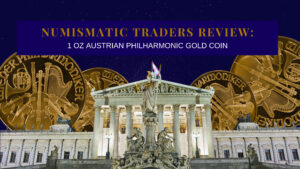Welcome to Numismatic Traders! We review the 1 oz Austrian Philharmonic Gold Coin also known as Vienna Philarmonic or simply “Philarmonic”. The 1 oz Philharmonic Gold Coin is regarded by many as the most reliable bullion coin in the world. Its reliability is depicted by the fact that this coin’s design has remained exactly the same (except for the year of issue) since its introduction in 1989.
When, in 1194, Richard the Lionheart paid 12 tonnes of silver to Duke Leopold V of Austria not only did he secure his freedom from a year of incarceration, he also unwittingly laid the foundations of the Austrian Mint. ~ From Austrian Mint official website
Austrian Mint
As the brief excerpt above implies, the Austrian Mint boasts a long, and compelling history of striking coins, but only in the mid 19th century was its feet planted in the center of Vienna, in Heumarkt, where it currently resides. Much credit is awarded to this tiny nation of exquisite art and brilliant minds, but among the most prominent vessels for the talent she fosters is the Austrian Mint. And of all the coins struck there the 1 ounce Vienna Philharmonic is the Magnus Opus.
A stable investment
In 1990 only one year after its introduction, it was the best selling gold coin in Europe and second-best worldwide. Then in 1992, it doubled up on its acclaim with being the bestselling gold coin across the globe. Showing that it was not mere luck, this feat was accomplished again in 1995, 1996, and 2000 – World Gold Council.
From the year 1989 up to 2012 over 14 million of the coin has been sold, which amounts to a weight of nearly 329 tons in Gold. In 2004, the Vienna Philharmonic accounted for 35 to 40% of sales in Europe and enjoys worldwide sales in places like Japan and North America.
Specifications of the standard 1 oz Austrian Philharmonic Gold Coin
Let’s jump into the technical specifications of this classic bullion coin.
- Gold content – 1 oz (Troy ounce
- Gold purity – 99.99% (24 carats)
- Weight – 31.10 g
- Diameter – 37.00 mm
- Thickness – 2.0 mm
- Face value – €100 fully backed by the Austrian government.
- Mint – Austrian Mint
The Philharmonic’s features
Vienna is famously known as the city of music and was at one point or another home to some of the biggest names in musical history. The delicate lines pressed into this precious metal shape the bodies of those most beloved instruments of the Musikverein’s Golden Hall.
The Obverse

At the top the words “Republik Osterreich” arch over a grand pipe organ centered in the middle of the coin.
Taking the front of Theophil Hansen’s Großer Musikvereinssaal the Musikverein pipe organ beams with a regality so very telling of the proud nation that birthed it. As much of the inspiration for the cultural boom that ensued during the renaissance can be attributed to the reminiscence of antiquity it seems fitting that the instrument should be adorned with Hellenistic features, complimenting the rich history of its music.
This style can be seen on the famed organ casing modeled on the obverse, with the organ itself being the fourth installment the building has seen since 1870.
The organ first built by Friedrich Ladegast gathered a number of technical complications in the end due to over-modification.
The second survived the blast of a grenade during the final chapters of WW2 in 1945, and was subsequently repaired in 1948, only to later be replaced by something more sophisticated, and electronic.
After the death of its master, German conductor Karl Richter in 1981, the third installment was judged to be ill-suited for its role as an orchestral instrument. Finally, near the end of the 20th century, the present-day Musikverein Pipe Organ with its 6,138 pipes and 81 stops was constructed, and on 26 March 2011 was blessed by Cardinal Christoph, the archbishop of Vienna.
In a line directly below the Musikverein Pipe Organ appears the words “1 UNZE GOLD 999.9” the year of issue is inscribed directly underneath the line. Concaved in a semi-circle at the bottom “100 EURO” completes the obverse of the Philarmonic gold coin.
The reverse

On the reverse is displayed an array of music instruments often associated with the Philharmonic arched by the words: “Wiener Philharmoniker”
Looking and describing the instruments from left to right:
The Vienna horn
Modifications to the natural horn made handling the imposing mass of brass tubing smoother and added versatility. And so with the addition of piston valves, the widening of the tube, an enlarged bell, and a number of other changes the Vienna horn made its way to the 19th-century auditorium.
The Bassoon
A woodwind instrument with two distinguished systems at hand, the Buffet from France, and the Heckel from Germany. It consists of two bores that can be made out of reeds or mapple, or synthetic materials such as ebonite, or polypropylene. The German reeds having spines that are thicker down the center, while the French reeds are beveled. Bassoons also entered the stage in the 19th century.
The Violin, and Viola
Few instruments can boast the esteem with which the violin has swerved the course of music. The viola is the violins baritone cousin, with a slight increment in size, and thicker strings. From the years of its creation in the 16th century in Northern Italy, and into the modern age its four strings have made legends out of studious devotees, bringing to mind names such as Mozart, Vivaldi, Bach and Pagannini just to name a few.
The Cello
Sharing most of its history and shape with that of the violin and viola the cello requires but a few words to distinguish it from the rest of its peers. It often featured five strings, and mostly reinforced the bass line in ensembles. It rose to prominence in the 17th, and early 18th century, but its size was only standardized in the mid 18th century. With a back length of up to 760mm (30 inches) and neck of 280mm (11 inches) it has proportionally deeper ribs and a shorter neck than the violin. Longer strings with more mass means the cello produces a more reverberant, deep sound when plucked.
The Harp
Perhaps the most ancient, and regal instrument of them all, the harp played in throne rooms from the days of the early Mesopotamians. In multiple cultural depictions from around the world, it appears with an almost holy undertone. Arpeggio is the act of plucking each string individually, while sweeping the hand across the strings is known as glissando. The type of harp expressed on this coin is called a pedal harp, which is a more modern invention possessing as a standard 47 strings, and 7 pedals.
The product range of the Austrian Philharmonic Gold Coin
For those individuals on a budget, the Austrian Mint produces four smaller additions to the 1 oz bullion coin. These smaller depictions of this famous one ounce gold coin are also popular for collecting as a set.
- 1/2 (half) oz Philarmonic gold coin has a face value of €50.
- 1/4 (quarter) oz Philarmonic gold coin has a face value of €25.
- 1/10 (tenth) oz Philarmonic gold coin has a face value of €10.
- 1/25 (one twenty-fifth) oz Philarmonic gold coin has a face value of €4.
Pros of the Philharmonic
-
Purity
99.99% Pure gold is nothing to scoff at and the purest form in which gold can be bought. The high purity gold combined with beautiful artistic design gives the coin an illustrious yellow gold color.
-
Backed by the Austrian Government.
The first legal tender gold coin to have its face value denominated in Euros, thus broadening its recognition and acceptability. From its introduction until the end of 2001 the coins were depicted in Austrian Shillings. From 2002 the 1 oz Philharmonic holds a face value of €100, as legal tender in the European Union.
-
The aesthetics of music
Music is a universal language. The instruments displayed on this coin is a picture that isn’t bound to any specific group of people. People from all over the world can relate to the Philarmonic’s design as it lacks cultural depiction to a specific person or group.
-
Usually Vat-free in Europe
In most European countries the Philharmonic is traded tax-free.
-
International champion
Four times the bestselling gold coin in the world means this beauty won’t be hard to find. The Philharmonic has been in continuous production for over 30 years with an unchanged design. In contrast with the Gold Britannia Coin that regularly changes design, it is perfectly positioned in the market to be highly liquid and internationally recognized.
-
Trade at a low premium
The Philharmonic trade at low premiums at esteemed brokers such as Goldbroker.
-
Mirror the price of gold as an investment
A sound choice with its fine gold content for investors to invest in gold where the value of the coin increases with the price of gold. Many people prefer to buy the Philharmonic Gold Coin as a saving due to its stability and international popularity.
-
Guaranteed by Austrian Mint
The Austrian Mint guarantees the purity and weight of all their coins.
-
Approved IRA tax investment
The Philharmonic meets the requirements to be included with an Independent Retirement Account. Tax benefits are bestowed upon these portfolios that include gold bullion investments.
Cons of the Philharmonic
It is difficult to find any negatives specifically associated with the 1 oz Austrian Philharmonic Gold Coin.
-
Not a legal currency
Outside of the European Union, this coin won’t be recognized as a legal currency.
-
Lack of security features
There is little in the way of additional features that distinguish the authentic from the fraud. Other Mints have done more to strengthen their coins’ security features. The Canadian Gold Maple Leaf and the Gold Britannia Coin are examples of coins that make counterfeiting extremely difficult and expensive.
-
Softness
A coin high in purity like the Philharmonic with its 24 Carat fine gold is prone to be easily scraped and damaged. Extra care needs to be taken when handling this coin. The purity feature makes buying slightly more difficult when the damage factor needs to be considered.
Final thoughts
Only a few gold bullion coins can match the Austrian Philharmonic Gold Coin. The coin originates from a Mint with a rich heritage of over 800 years. The Austrian Mint is known for producing some of the finest coins in the world. Its trading knows no borders as it still soars across the international market, recently gaining the interest of the economic giant that is China. Therefore when you buy a Philharmonic gold coin you get gold, packed with reliability, good performance in the market, high purity and charming good looks. Given its reputation for stability, I’d say this gold bullion coin is a serious consideration when you are looking at buying gold. If you are a European Citizen the Philharmonic gold coin should be on top of your list of coins to own.



